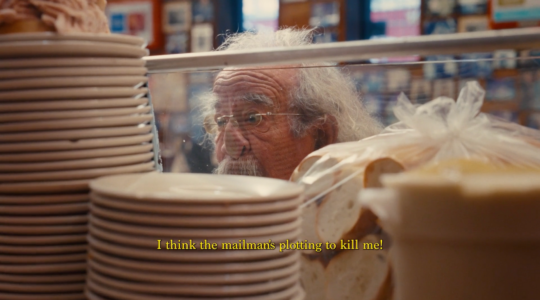About 90 minutes into Amie Siegel’s clever, witty rumination on the former East Germany, “DDR/DDR,” Siegel and her crew get into a spirited discussion about the best way to translate the German word “Wende,” literally “change,” since it used to refer to the series of upheavals that began with the fall of the Berlin Wall and ended after the reunification of Germany. One of her German crew members snaps, “How much of your audience will understand the politics anyway?” The answer, judging from the many interviews with residents of the now-vanished nation that constitute the bulk of her film, is probably “at least as high a percentage as those who lived through them.”
“DDR/DDR,” which begins a week-long run at Anthology Film Archives on May 7, is described as a “visual essay” in reverse shots; it’s a label that makes perfect sense when you realize that the title actually is a mirror image with the first set of initials reversed, then spelled out on the other side of the slash. Like the graphic design of its title, “DDR/DDR” is a cunningly devised metaphor for looking into the rear-view mirror to see “a country long over,” as Siegel’s voiceover calls it.
Appropriately, the film centers on a series of metaphors based on notions of how we (literally) depict the past, whether through psychotherapy, the creation of archives, personal history or personal and national myths. Early in the film, one of Siegel’s interview subjects says, “Everything bad ‘came from the other side.’ We could say, ‘We’re an anti-Fascist people’ or ‘Our leaders are anti-Fascist, so the entire people are exculpated … the imperialists and old Nazis live in the West.’”
This comfortable myth, actually written into the Deutsche Democratic Republic’s constitution, allowed citizens to ignore the racial nature of the Nazi state and to submerge Jewish suffering in the Shoah into a larger vision of staunch resistance to Fascism. Of course, as much of the film documents, the tactics of the Stasi, the East German secret police, differed from those of the Gestapo only in their degree of subtlety, the nature of their targets (basically any citizen who manifested the slightest hesitation about the DDR) and the absence of genocide from their agenda. As we well know, many former Gestapo officers ended up working with the Stasi.
But, Siegel argues convincingly, just as the German people on both sides of the Wall managed to give themselves “collective amnesia of before the [Second World] War,” now “the Communist past is being erased,” likewise, fading in the rear-view mirror of history.
Siegel finds two brilliant metaphors for this dilemma, and dedicates long passages of the film to exploring them, at first obliquely, then with satisfying directness. The first of these themes is the function (or lack thereof) of psychoanalysis in the DDR. She interviews two psychiatrists who speak eloquently about the suppression of such personal therapies as “bourgeois,” and the valorizing of group therapy as more suitable to a collectivist nation. At least one member of every therapy group was a Stasi agent or informer, so collective “security” was safeguarded at the same time. In a film that is full of allusions to dreams and dream projections, with the Stasi a sort of “return of the repressed” of the Nazi state, these sequences are particularly apt and compelling.
The other major point of reference almost defies belief: within the DDR there was a small but vigorous group of hobbyists who fixated on Native Americans. German popular culture has had a fascination with America’s indigenous population since the 1880s, when Buffalo Bill’s Wild West Show enjoyed huge popularity there. Karl May, a dedicated hack novelist, carried that interest through a formidable series of novels in which Native American heroes fought off greedy, rapacious whites; May was, notoriously, Adolf Hitler’s favorite author. In the DDR, this adulation of all things Indian resulted in a dozen “sauerbraten westerns” in which white imperialist bad guys murdered innocent Indians until they were finally forced to seek vengeance for what Siegel cannily calls “violent pogroms.” That is a term that is seldom used to refer to any racial violence except the anti-Semitic, and on some perverse level, DDR fascination with the genocide practiced on Native Americans is obviously a displacement of guilt for a very different series of transportations and mass murders. (In fact, one of the German “Indians” Siegel interviews is the great-great grandson of von Neurath, Hitler’s foreign minister for six years.)
The great strength of “DDR/DDR” is that Siegel lets the audience make these connections for itself, using a carefully modulated collection of interview materials interspersed with previously unseen footage from the Stasi archives. The film is a complex mosaic of thoughts that cover the assaultive nature of filmmaking itself, the traumas of reunification in the East and the bizarre nostalgia for East German goods (including some of the ugliest “modern” furniture ever devised by the mind of man). It is no small tribute to Siegel, a Chicago-born video and film artist now living in Berlin, that the film does more than juggle all these disparate elements. Rather, it interweaves them with a remarkably deft hand in what is one of the most entertaining and smart documentaries of the year.
“DDR/DDR” will play May 7-13 at Anthology Film Archives (Second Avenue and 2nd Street); Siegel will appear at the opening night screening. For information, call (212) 505-5181 or go to www.anthologyfilmarchives.org.
|
Signup for our weekly email newsletter here. Check out the Jewish Week’s Facebook page and become a fan! And follow the Jewish Week on Twitter: start here. |
The New York Jewish Week brings you the stories behind the headlines, keeping you connected to Jewish life in New York. Help sustain the reporting you trust by donating today.




